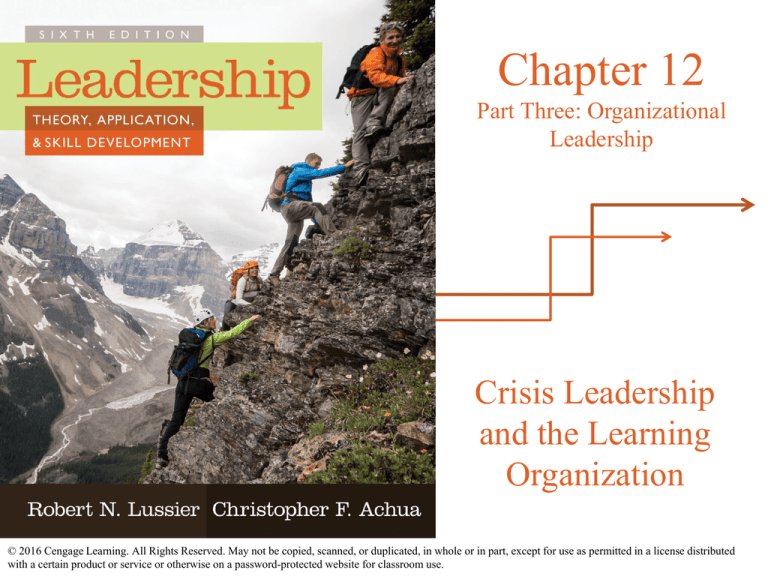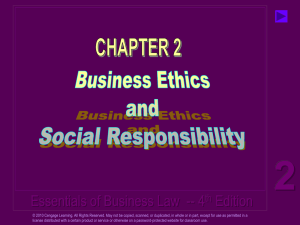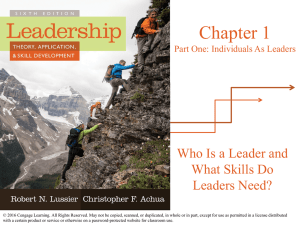
Chapter 12
Part Three: Organizational
Leadership
Crisis Leadership
and the Learning
Organization
© 2016 Cengage Learning. All Rights Reserved. May not be copied, scanned, or duplicated, in whole or in part, except for use as permitted in a license distributed
with a certain product or service or otherwise on a password-protected website for classroom use.
12- 1
Learning Outcomes
1) Explain why crisis leadership competency is an important
consideration when hiring new leaders.
2) What are the benefits of having a crisis management plan in
advance of a crisis?
3) Briefly describe the three stages of a crisis management plan.
4) Describe the role of top management during a crisis.
5) Describe the five-step process for crisis risk assessment.
6) Describe the importance of effective communication during a
crisis.
7) Describe the key characteristics of a learning organization.
8) Distinguish between the traditional and the learning organization.
9) Describe the role of leadership in creating a learning organization
culture.
© 2016 Cengage Learning. All Rights Reserved. May not be copied, scanned, or duplicated, in whole or in part, except for use as permitted in a license distributed
with a certain product or service or otherwise on a password-protected website for classroom use.
12- 2
Crisis
• A crisis is a low-probability, but high-impact
event that threatens the viability of an
organization and is characterized by
ambiguity of cause, effect, and means of
resolution, as well as by a belief that
decisions must be made swiftly.
> Comes in many forms:
o
o
o
o
o
Natural disasters,
Mass shootings,
Product failures,
Human error disasters, and
System failures.
© 2016 Cengage Learning. All Rights Reserved. May not be copied, scanned, or duplicated, in whole or in part, except for use as permitted in a license distributed
with a certain product or service or otherwise on a password-protected website for classroom use.
12- 3
Crisis Leadership
In planning for a crisis, leaders
focus on five integrated tasks:
1.
2.
3.
4.
5.
Formulate a vision of crisis
management.
Establish strategic goals
and objectives for crisis
management.
Coordinate the creation of
a crisis management plan.
Establish a communication
plan.
Develop simulations and
drills.
These five tasks are essential
competencies of crisis leaders,
the ability to:
• Craft a vision.
• Set objectives.
• Formulate, execute and
evaluate crisis plans.
• Communicate.
• Manage people.
© 2016 Cengage Learning. All Rights Reserved. May not be copied, scanned, or duplicated, in whole or in part, except for use as permitted in a license distributed
with a certain product or service or otherwise on a password-protected website for classroom use.
12- 4
Crisis Communication in the Age of
Social Media
• Social networks must be a part of an
integrated communication strategy.
• Technologies diminish an organization’s
ability to control crisis communications.
> A crisis is instantly visible, and viral.
> Companies have only minutes to contain a
crisis.
> Stakeholders may have more information about
the crisis than the company itself.
© 2016 Cengage Learning. All Rights Reserved. May not be copied, scanned, or duplicated, in whole or in part, except for use as permitted in a license distributed
with a certain product or service or otherwise on a password-protected website for classroom use.
12- 5
Formulating a Crisis Plan
• Better prepared organizations could
reposition themselves and turn a crisis event
into a strategic opportunity.
• Readiness to respond is a function of:
> The skills, abilities and experience of crisis leader,
> A trained and well prepared crisis team,
> Organizational preparedness,
> Adequate organizational resources, and
> Top management support and commitment.
© 2016 Cengage Learning. All Rights Reserved. May not be copied, scanned, or duplicated, in whole or in part, except for use as permitted in a license distributed
with a certain product or service or otherwise on a password-protected website for classroom use.
12- 6
The Benefits of a Crisis Plan
• Reduces duration of crisis
• Enhances corporate image
• Allows for quick and
effective responses
• Improves communication
• Enhances coordination and
cooperation
• Can lead to the accumulation
of ready resources
• Can lead to fewer costly
mistakes
• Creates less panic
• Leads to a quicker resolution
• Limits financial loss
© 2016 Cengage Learning. All Rights Reserved. May not be copied, scanned, or duplicated, in whole or in part, except for use as permitted in a license distributed
with a certain product or service or otherwise on a password-protected website for classroom use.
12- 7
Pre-Crisis Planning
• Pre-crisis planning addresses:
> Do we have a crisis response team/who is on it?
o
Want a mix of people from all parts of the organization.
> What is our crisis plan of action?
o
Should evaluate the worst possible scenarios .
> Do we have all the necessary resources in place?
o
Both financial and nonfinancial resources are needed.
> Another aspect is deciding on the appropriate
communications strategy.
See Exhibit 12.1.
© 2016 Cengage Learning. All Rights Reserved. May not be copied, scanned, or duplicated, in whole or in part, except for use as permitted in a license distributed
with a certain product or service or otherwise on a password-protected website for classroom use.
12- 8
Leading during a Crisis
• When crisis erupts, a rapid response is vital.
• The crisis leader must step forward and lead.
> Focusing on three key elements:
o
o
o
Goals – define the ‘What’
People – define the ‘Who’
Resources – define the ‘how’.
• Effective leadership from the top is critical.
> Basic lesson is prepare for crises, respond quickly,
act with integrity, and disclose fully.
© 2016 Cengage Learning. All Rights Reserved. May not be copied, scanned, or duplicated, in whole or in part, except for use as permitted in a license distributed
with a certain product or service or otherwise on a password-protected website for classroom use.
12- 9
Adapting After a Crisis
• After a crisis, a review should include:
> Effectiveness in stakeholder communication,
> Effectiveness in addressing the root cause,
> Crisis team effectiveness,
> Leadership effectiveness, and
> Effectiveness in dealing with victims.
• Information gathered in the post-crisis
evaluation helps prevent future crises.
© 2016 Cengage Learning. All Rights Reserved. May not be copied, scanned, or duplicated, in whole or in part, except for use as permitted in a license distributed
with a certain product or service or otherwise on a password-protected website for classroom use.
12- 10
Five-Step Risk Assessment Model
• Ultimately, these five factors determine
readiness:
1. Quality of crisis plan,
2. Awareness/access to crisis management
information,
3. Readiness for a timely response,
4. Effective communication plan in place, and
5. Effective crisis leadership.
See Exhibit 12.2.
© 2016 Cengage Learning. All Rights Reserved. May not be copied, scanned, or duplicated, in whole or in part, except for use as permitted in a license distributed
with a certain product or service or otherwise on a password-protected website for classroom use.
12- 11
Effective Crisis Communication
• Leaders must be able to communicate
quickly and effectively during crises.
> Four questions often emerge:
1.
2.
3.
4.
What happened?
How did it happen?
What’s being done to address the crisis?
What has been done to ensure it never happens
again?
• Providing honest, accurate, and timely
answers is effective crisis communication.
© 2016 Cengage Learning. All Rights Reserved. May not be copied, scanned, or duplicated, in whole or in part, except for use as permitted in a license distributed
with a certain product or service or otherwise on a password-protected website for classroom use.
12- 12
Guidelines to Effective Crisis
Communication
• The first 24 hours of a crisis are crucial.
• Organizations can use media and tools to
inform the public.
> A press release is a printed statement that
describes how an organization is responding to a
crisis and who is in charge.
> A press kit is a package of information about a
company, including names and pictures of its
executives, a fact sheet, and key milestones in the
company’s history.
See Exhibit 12.3.
© 2016 Cengage Learning. All Rights Reserved. May not be copied, scanned, or duplicated, in whole or in part, except for use as permitted in a license distributed
with a certain product or service or otherwise on a password-protected website for classroom use.
12- 13
The Learning Organization and
Knowledge Management
• Organizations are increasingly dependent
on innovation to create value for
customers.
• In a knowledge-based economy, learning
and creativity are key to competition.
• Leaders must develop knowledgeintegration capabilities.
• Organizational learning is the pathway to
knowledge-creation – a strategic resource.
© 2016 Cengage Learning. All Rights Reserved. May not be copied, scanned, or duplicated, in whole or in part, except for use as permitted in a license distributed
with a certain product or service or otherwise on a password-protected website for classroom use.
12- 14
Learning Organization Characteristics
• Learning organizations have the following:
> Continuously adapted and improved,
> Everyone engages in continuous learning,
> The culture supports creativity and innovation,
> Knowledge creation is imperative, and
> Decision making is informed by facts/analysis.
• A learning organization is skilled at creating,
acquiring, and transferring knowledge, and at
modifying behavior to reflect new knowledge
and insights.
© 2016 Cengage Learning. All Rights Reserved. May not be copied, scanned, or duplicated, in whole or in part, except for use as permitted in a license distributed
with a certain product or service or otherwise on a password-protected website for classroom use.
12- 15
What is Knowledge Management?
• Organizational knowledge is the tacit and
explicit know-how that individuals possess
about products, services, systems, and
processes.
> Explicit or formal knowledge is often codified.
> Tacit knowledge is the instinct and intuition an
experienced practitioner possesses.
> Also referred to as intellectual or human capital.
© 2016 Cengage Learning. All Rights Reserved. May not be copied, scanned, or duplicated, in whole or in part, except for use as permitted in a license distributed
with a certain product or service or otherwise on a password-protected website for classroom use.
12- 16
The Learning Organization Culture
and Firm Performance
• Key differences between the traditional and the
learning organization.
See Exhibit 12.4.
• Higher levels of learning/knowledge creation relate
to higher firm performance.
> Firm’s ability to create/share knowledge is positively
related to product development.
> Productivity and profits increase.
> Team creativity and innovation increase.
> Direct positive impact on employee, customer, and
supplier satisfaction.
> Increased organizational citizenship.
See Exhibit 12.5.
© 2016 Cengage Learning. All Rights Reserved. May not be copied, scanned, or duplicated, in whole or in part, except for use as permitted in a license distributed
with a certain product or service or otherwise on a password-protected website for classroom use.
12- 17
Key Terms
• benchmarking
• crisis
• discontinuous
change
• learning
organization
• organizational
knowledge
• press kit
• press release
© 2016 Cengage Learning. All Rights Reserved. May not be copied, scanned, or duplicated, in whole or in part, except for use as permitted in a license distributed
with a certain product or service or otherwise on a password-protected website for classroom use.
12- 18






